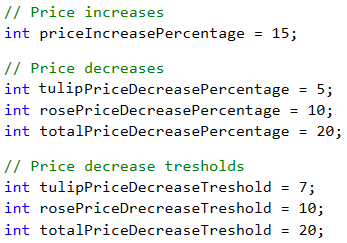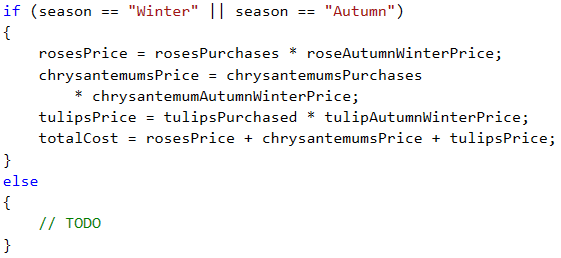Problem: Flowers Shop
A flowers shop offers 3 types of flowers: chrysanthemums, roses and tulips. The prices depend on the season.
| Season | Chrysanthemums | Roses | Tulips |
|---|---|---|---|
| spring / summer | 2.00 USD/pc | 4.10 USD/pc | 2.50 USD/pc |
| autumn / winter | 3.75 USD/pc | 4.50 USD/pc | 4.15 USD/pc |
On holidays, prices of all flowers are increased by 15%. The following discounts are offered:
- For purchasing more than 7 tulips in spring – 5% of the price of the whole bouquet.
- For purchasing 10 or more roses in winter – 10% of the price of the whole bouquet.
- For purchasing more than 20 flowers in total in any season – 20% of the price of the whole bouquet.
Discounts are made in the above described order and can be combined! All discounts are valid after increasing of the price on a holiday!
The price for arranging a bouquet is always 2 USD. Write a program that calculates the price of a bouquet.
Input Data
The input is read from the console and contains exactly 5 lines:
- The first line contains the number of purchased chrysanthemums – an integer within the range [0 … 200].
- The second line contains the number of purchased roses – an integer within the range [0 … 200].
- The third line contains the number of purchased tulips – an integer within the range [0 … 200].
- The fourth line indicates the season – [Spring, Summer, Autumn, Winter].
- The fifth line specifies if the day is a holiday – [Y = yes / N = no].
Output Data
Print on the console 1 number – the price of flowers, formatted up to the second digit after the decimal point.
Sample Input and Output
| Input | Output | Comments |
|---|---|---|
| 2 4 8 Spring Y |
46.14 | Price: 2*2.00 + 4*4.10 + 8*2.50 = 40.40 USD |
Holiday: 40.40 + 15% = 46.46 USD
5% discount for more than 7 tulips in spring: 44.14
The flowers are in total 20 or less: no discount
44.14 + 2 for arranging the bouquet = 46.14 USD|
| Input | Output | Comments |
|---|---|---|
| 3 10 9 Winter N |
69.39 | Price: 3*3.75 + 10*4.50 + 9*4.15 = 93.60 USD |
Not a holiday: no increase in price
10% discount for 10 or more roses in winter: 84.24
The flowers are in total over 20: 20% discount = 67.392
67.392 + 2 for arranging the bouquet = 69.392 USD|
| Input | Output |
|---|---|
| 10 10 10 Autumn N |
101.20 |
Hints and Guidelines
We will divide the problem into smaller sub-problems, as described below.
Separating the Constant Values in Variables
After carefully reading the requirements, we understand that once again we need to do simple calculations, however this time we will need additional logical conditions. We need to pay more attention to the moment of making changes in the final price, in order to be able to properly build the logic of our program. Again, the bold text gives us sufficient guidelines on how to proceed. For a start, we will separate the already defined values in variables, like we did in the previous tasks:

We will also do the same for the rest of the defined values:

Reading the Input Data
Our next sub-task is to read properly the input data from the console. We will do that in the familiar way, but this time we will combine two separate functions – one for reading a line from the console and another one for its conversion into a numeric data type:

Preparing the Program Logic
Let's think of the most appropriate way to structure our programming logic. By the requirements it becomes clear that the path of the program is divided mainly into two parts: spring / summer and autumn / winter. We can do the separation by conditional statement, by storing variables in advance for the prices of the individual flowers, as well as for the end result.

What remains is to perform a few checks regarding the discounts of the different types of flowers, depending on the season, and to modify the end result.
Testing in the Judge System
Test your solution here: https://judge.softuni.org/Contests/Practice/Index/517#2.